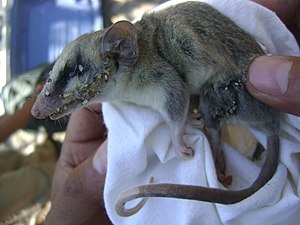Gray dwarf pouch rat
| Gray dwarf pouch rat | ||||||||||||
|---|---|---|---|---|---|---|---|---|---|---|---|---|

Gray bag rat ( Tlacuatzin canescens ) |
||||||||||||
| Systematics | ||||||||||||
|
||||||||||||
| Scientific name of the genus | ||||||||||||
| Tlacuatzin | ||||||||||||
| Voss & Jansa , 2003 | ||||||||||||
| Scientific name of the species | ||||||||||||
| Tlacuatzin canescens | ||||||||||||
| ( Allen , 1893) |
The gray dwarf rat ( Tlacuatzin canescens ) is a species of mammal from the family of the opossum (Didelphidae).
description
As the name suggests, it is characterized by its gray or gray-brown fur, with the underside being lighter, almost yellowish. The large, hairless ears are striking. The tail, which becomes as long as the body, can be used as a prehensile tail. These animals reach a head body length of 10 to 18 centimeters and a tail length of 11 to 17 centimeters. Their weight is 40 to 60 grams.
Distribution & habitat
The gray pygmy rat is endemic to Mexico , where it is found on the Pacific coast and the Yucatán Peninsula . Their habitat are predominantly tropical forests, but they also occur in plantations. It is a nocturnal loner who lives more on the ground than other small opossum species.
nutrition
It is an omnivore that feeds on insects, small vertebrates, and fruits.
Systematics
Initially, the species was classified in the genus of the dwarf pouch rats ( Marmosa ), clear differences in the structure of the skull and teeth as well as in the number of chromosomes led Robert S. Voss to establish the new genus Tlacuatzin for the species in 2003 . The generic name comes from the Nahuatl language and means opossum.
literature
- Voss, RS & Jansa, SA, 2003: Phylogenetic studies on didelphid marsupials II. Nonmolecular data and new IRBP sequences: Separate and combined analyzes of didelphine relationships with denser taxon sampling. In: Bulletin of the American Museum of Natural History. Vol. # 276, pp. 1-82
Web link
- Tlacuatzin canescens onthe IUCN 2013 Red List of Threatened Species . Posted by: Cuarón, AD, Emmons, L., Helgen, K., Reid, F. & Vazquez, E., 2008. Retrieved December 29, 2013.
